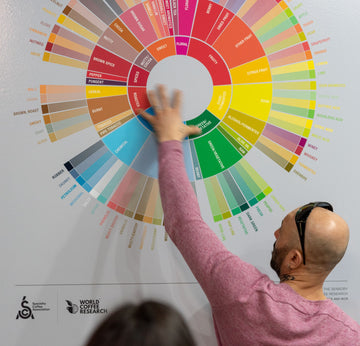
Some like it dark. Others like it light. Some want bold and chocolatey. Others prefer bright and floral. Ever wonder why coffee tastes so different from one roast to another? Or why cream tastes so good in dark coffee but “off” in light roasts? To help you answer some of those questions and give you the confidence to know which coffee YOU prefer, we’ll take the next few minutes to unpack the key differences between light, medium, and dark roast coffee.
Light vs Medium vs Dark - what makes them different?
It all begins with the bean. Depending on the origin, processing method at origin, varietal, micro-climate in which the plants grow, and harvest conditions, every lot of coffee beans has its own unique flavours. It’s up to the Roastmaster (the person who operates the machine that roasts the coffee) to figure out which roast best suits the bean. He (in Equator’s case) creates a roast curve, the “recipe” for how to roast that particular lot of coffee. There’s no rulebook for how this gets done (though there are lots of opinions!); most of it is trial and error at first and then refinement every time you roast. Using science, the roastmaster monitors the temperature, the time, the speed of the drum (which rotates the beans around and around like a dryer), and the air flow to follow the established curve. Using art (and his senses), the roastmaster continually samples the beans during the roast, looking for the colour and smell he’s aiming to achieve. Once it’s there, he drops the beans into the cooling tray. At Equator, we’ve been roasting a variation of the curves developed back in the late ‘90s when Craig fired up his 10kg Toper roaster and started crafting Freakin’ Good Coffee! .
As the term implies, light roast coffees are literally less roasted (less heat exposure) than dark or medium roast coffees. Light roast coffee will be lighter in colour, a dull caramel brown. Dark roast coffees are a deep dark-chocolate brown that can start to become shiny over time (more on that here).
Flavour and Aroma
It doesn’t take a professional cupper (i.e. coffee taster - yes, a real job!) to detect the difference between dark and light roasts. As mentioned above, every lot of coffee has different flavour compounds. Generally speaking, the lighter the roast, the more you can taste the subtler flavour notes. Less time in the heat means less is literally roasted out of the bean which is why single origin (from one country/region) coffees are generally roasted lightly. The coffee's processing and terroir shines through and the roast accentuates the ‘true’ flavour of the coffee. Did you know that coffee has over 110 flavour, aroma, and texture attributes? Grapefruit, hazelnut, nutmeg, rose, whiskey - all detectable notes (with nothing added) in coffee. The lighter the roast, the more you’ll taste.
Dark roast coffees are exposed to heat for longer and lose more moisture during the roasting process. More heat means more the bean takes on more of the roast flavour and loses the brighter, lighter, more “delicate” notes. Flavour compounds like chocolate, brown spice, molasses, tobacco hold up well in the heat and can complement the smokiness of the roast flavour. Think of toasting bread - the longer the bread is in the toaster, the more you’ll start to taste “toasty” and less “rye” (or whatever slice you like). Same goes for coffee. And if you like your coffee with cream, you’ll need a deep dark roast to hold up to the power of the dairy!
Caffeine content
People often wonder about the reported difference in caffeine content. While roast plays a role, equally important is the brewing method (more contact with water = higher level of caffeine extraction). The altitude, varietal, origin of the coffee also impact its caffeine.
But in general, it’s safe to assume that as coffee gets roasted, parts of the coffee get roasted out. Many scientists believe that the compound responsible for caffeine also gets released in the exhaust. That said, the difference is fairly minimal and our rule of thumb is that if you are sensitive enough to caffeine to notice a difference between dark and light roasts, you should definitely be careful about how much of any kind of coffee you consume! And once again, be mindful of the brewin method as well as the coffee to water ratio.
Body
Body is another word for mouthfeel. How does it feel when you roll it around in your mouth? Like 2% milk? Or more like skim milk? Might seem subtle to you but these are key differences. Light roast coffees can be lighter in body. Think of a tea-like body with a clean finish. Dark roasts are full-bodied and creamy with a lingering mouthfeel.
Preparation
To prepare coffee, you can follow our brew guide. The beans should be weighed and ground according to the brew method you choose. The water should be just off the boil: 190° for dark roasts, and 205° for light roasts.
Once the coffee is ready, you can enjoy it black or with milk and sugar. Because light roast coffee is generally brighter in flavour,, lighter in body, and brewed at a hotter temperature, some super light, acidic coffees have been known to curdle milk!. Dark roast coffees are bold and can stand up to milk and sugar. Dark roasts also have a tendency of being quite bitter, and are often cut with cream and sugar. One of our favourite ways to enjoy dark roast coffee is in a café au lait (50% dark roast coffee, 50% steamed milk).
How to choose the right coffee for you?
While some coffee-lovers will argue that light roast is better and dark roast is burnt, we are here to tell you to drink the coffee you enjoy the most. If you are looking for something more adventurous and complex? Light roast coffee is a great choice. Are you looking for something familiar, comforting, and luscious that tastes great on it’s own or with milk and sugar? Dark roast coffees will taste like a warm hug.
To get notified when we publish new blog posts like this, subscribe to our newsletter!
